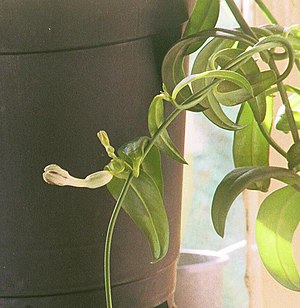Ceropegia crassifolia
| Ceropegia crassifolia | ||||||||||||
|---|---|---|---|---|---|---|---|---|---|---|---|---|

Ceropegia crassifolia |
||||||||||||
| Systematics | ||||||||||||
|
||||||||||||
| Scientific name | ||||||||||||
| Ceropegia crassifolia | ||||||||||||
| Harv. ex Hook.f. |
Ceropegia crassifolia is a species of the subfamily of the silk plants (Asclepiadoideae). It is common in Africa from Kenya in the north to South Africa.
features
Vegetative characteristics
Ceropegia crassifolia is a perennial plant with spindle-shaped, fleshy roots in clusters. The mostly annual, grooved, unbranched to little branched stem axes stand upright, grow creeping, or wind up to 2 m high. They have a diameter of 2 to 5 mm and are succulent . The leaves are short stalked. The more or less succulent, fleshy leaf blades are linear to broadly elliptical-lanceolate in shape and hairy. They measure 3 to 10 cm in length and 0.5 to 4.5 cm in width. The midrib is very pronounced on the top and bottom. The edges are often wavy or finely sawn.
Inflorescence and flowers
The inflorescences arise from the leaf axils and have 3 to 7 flowers. However, the flowers open one after the other, rarely two flowers are open at the same time. During the anthesis, the flowers smell like cow dung or rot. The inflorescence stalk is 3 to 30 millimeters long. The flower stalks are 2 to 5 mm long with a diameter of 1 to 2 mm. The sepals are narrow-lanceolate and up to 5 mm long. The five petals are fused into the lower two thirds of the 2 to 5 cm high, almost straight to slightly curved corolla to form a smooth corolla tube ( sympetalie ). They are bright greenish-yellow in color with purple spots. At the base, the kettle is spherical to ovoid with a diameter of 6 to 9 mm. The crown bowl merges into the actual crown tube, which has a minimum diameter of 3 to 5 mm. It is hairy on the inside. Towards the opening it widens in a funnel shape and has a diameter of up to 9 mm. The petals are 4 to 15 mm long and 2 to 4 mm wide. The tips are fused together and form a flattened-egg-shaped to flattened-spherical cage-like structure. The bald lamina are bent back along the midrib. The whitish corolla is sessile to short-stalked and fused together in the shape of a bowl or cup. The interstaminal corolla lobes are pocket-shaped, rounded in outline, rectangular to ovoid. They are about 1 mm long, are almost horizontal to upright and are blunt or slightly incised at the outer end and usually hairy. The lobes of the staminal corolla are rectangular to linear-sub-crown and 0.5 to 1.5 mm long. They lie on the back of the stamens . The pollinia are spherical-ovoid and measure 0.4 × 0.25 mm;
Fruits and seeds
The paired follicles are at an angle of about 60 °, are 7 to 10 centimeters long with a diameter of 3 to 4 millimeters. The seeds are 6 to 7 mm long and 2 to 3 mm wide. They are dark brown, the edges lighter. The head of hair is 2 to 2.5 cm long.
Similar species
The species is closely related to Ceropegia nilotica and Ceropegia stenantha .
Geographical distribution and ecology
The species occurs in the Eastern Cape Province in South Africa as well as in Namibia , Kenya , Botswana , Zimbabwe and Swaziland .
In Kenya, the Ceropegia crassifolia var. Copleyae occurs in the grasslands together with Acacia drepanolobium . It grows there in the partial shade of bushes or trees at 1600 to 1850 m above sea level. Due to the rather intensive grazing of the grasslands, Ceropegia crassifolia remains small here and is often reduced to dwarfism.
Systematics and taxonomy
The taxon was first described by Rudolf Schlechter in 1895. Today a distinction is made between two varieties:
- Ceropegia crassifolia var. Crassifolia (Syn .: ceropegia Brachyceras Bad (1905), ceropegia crispata N. E. Brown (1908), ceropegia thorncroftii N. E. Brown (1912) and ceropegia tuberculata Dinter (1923))
- Ceropegia crassifolia var. Copleyae (EA Bruce & PRO Bally) H. Huber . This variety is distinguished by the linear leaves, which are 3 to 5 mm wide; they are V-shaped in cross section. The corolla is light green-yellow. The petal lobes are shorter and relatively wider. The lamina are only half curved outward along the midrib and have whitish eyelashes along the edges. The secondary crown is cup-shaped and as high as the gynostegium. The tips of the interstaminal corolla are slightly incised or edged at the outer end. The tips of the staminal secondary crown are short rectangular and lie on the anthers. The nearly square stamens rest on the stylus head and protrude above it. The pollinia are egg-shaped and measure 0.28 × 0.2 mm.
supporting documents
literature
- Henk J. Beentje (Eds.), David Goyder, Timothy Harris, Siro Masinde, Ulrich Meve, Johan Venter: Flora of Tropical East Africa, Apocynaceae (Part 2). Royal Botanic Gardens, Kew, 2012, ISBN 978-1-84246-396-3 , pp. 115-530 ( C. crassifolia p. 280/1).
- Robert Allen Dyer: Ceropegia, Brachystelma and Riocreuxia in southern Africa. VIII, 242 pp., Rotterdam, Balkema, 1983 ISBN 90-6191-227-X (pp. 179-181)
- Herbert FJ Huber : Revision of the genus Ceropegia. In: Memórias da Sociedade Broteriana , Volume 12, 1957, pp. 1–203, Coimbra (pp. 100–102)
- Ulrich Meve: Ceropegia . In: Focke Albers, Ulrich Meve (Hrsg.): Succulents Lexicon Volume 3 Asclepiadaceae (silk plants) . Pp. 61-107, Eugen Ulmer Verlag, Stuttgart 2002. ISBN 3-8001-3982-0
Individual evidence
- ^ Rudolf Schlechter: Contributions to South African Asclepiadology. In: Journal of Botany , Volume 33, 1895, pp. 267-274, London Online at www.biodiversitylibrary.org (p. 273)